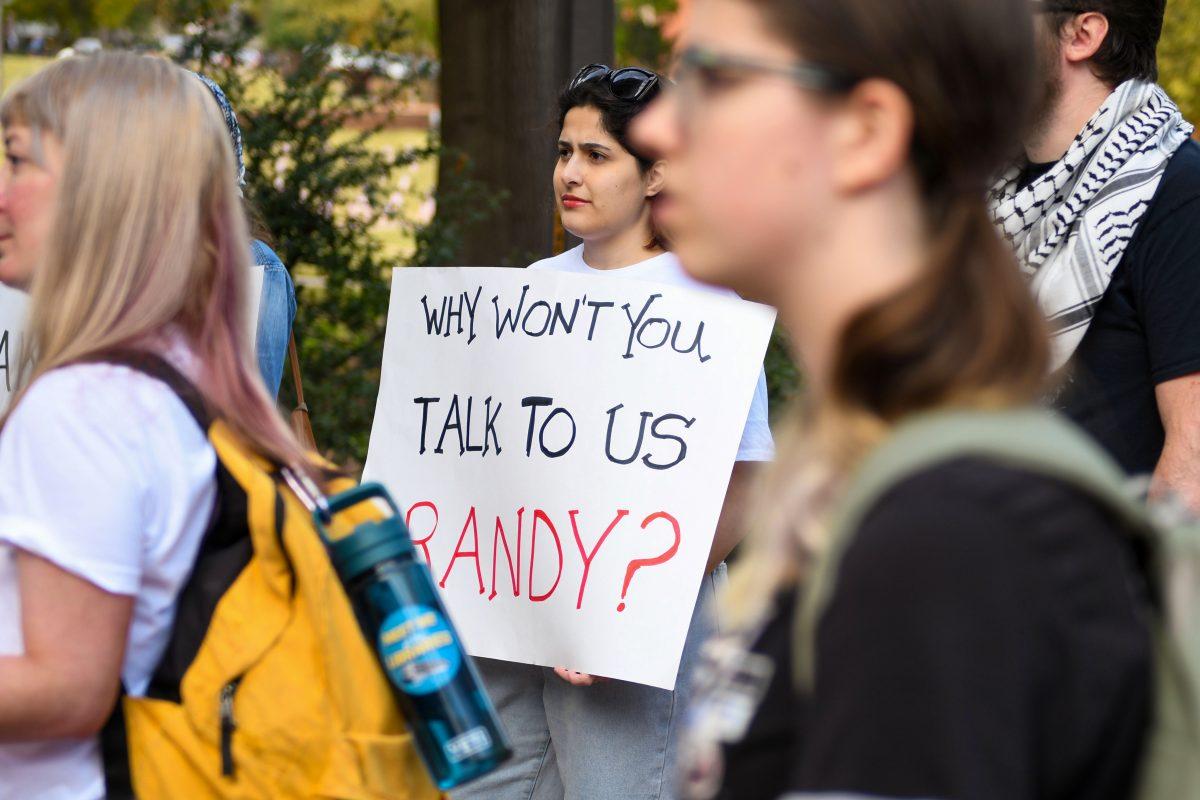Two days after the one-year anniversary of Poe Hall’s closure due to PCB contamination, students and activists gathered outside the building Tuesday to protest NC State’s handling of the situation.
The Campus Community Alliance for Environmental Justice, or CCAEJ, a student-led coalition, organized the demonstration to deliver a petition with about 1,300 signatures to Chancellor Randy Woodson’s office. The petition outlines six demands, including contacting all individuals potentially exposed to PCBs in Poe Hall since the building’s opening in 1971 and providing compensation for health screenings and medical costs.
Celine Shay, a graduate student studying public history and a member of CCAEJ, prefaced the starting of the group’s demands with a message of solidarity with everyone affected by the contamination.
“We’re not asking, we’re demanding today, but we also stand here today on behalf of the over 500 people who have been diagnosed with cancer or other life-altering illnesses because of the time they spent in this building and this building that we’re standing outside of right now,” Shay said. “Some of them are too sick to be able to be here with us. Some are not able to leave their homes or be amongst other folks. Some have died. We know that this is not right, and we know it can’t keep happening.”
Shay said she was disappointed with the University’s progress and transparency regarding environmental safety.
“Chancellor Woodson and other University administrators have had an entire year and they’ve only let us down,” Shay said. “NC State has contributed to a climate of fear about the safety of our campus.”
Protesters marched from Poe Hall to Holladay Hall chanting phrases such as “Cancer Chancellor.” At Holladay, they put up a poster titled “Why won’t you talk to us Randy?” as well as a list of detailed demands and the names of everyone who signed the petition to the locked doors, which stretched down the building’s steps. The group said they are giving Woodson 30 days to provide written documentation on how he plans to address the demands.
University Spokesman Mick Kulikowski said the University has received the petition in an email to Technician.
“The safety of the NC State community has always been — and will continue to be — a top priority for the university,” Kulikowski wrote. “Since Poe Hall was proactively and voluntarily closed last year, NC State has regularly shared information, updates and test results directly with the university community.”
Along with the Geosyntic report, Kulikowski highlighted the active Health Hazard Evaluation being conducted by the National Institute for Occupational Safety and Health in Poe Hall.
Chelsea Lundquist-Wentz, a founding member of CCAEJ and third-year doctoral student, said she and other CCAEJ members feel that University administrators have shown a lack of empathy in their response.
“The lack of empathy is something that’s really disturbing from [Woodson] and the other administrators because they refuse to acknowledge the health consequences of PCBs,” Lundquist-Wentz said. “ … It seems very clear that [Woodson is] protecting himself and the University, and not the actual people that make up the University.”
The CCAEJ’s demands include contacting all individuals potentially exposed to PCBs in Poe Hall since 1971, compensating affected individuals for health screenings and medical costs, commissioning an independent review of the Geosyntec report, establishing an independent reporting system for environmental health concerns, testing all campus buildings for environmental contaminants and keeping Poe Hall closed until independently verified as safe.
Eric Martineau, a fourth-year studying environmental science and plant biology, attended the protest after learning about it at a recent environmental science fraternity meeting. While not a CCAEJ member, Martineau said he was concerned about potential PCB contamination in other campus buildings.
“I feel like Poe Hall was just the one that got caught in my opinion,” Martineau said. “I’d like to know because I do not trust the Geosyntec report.”
Martineau said there is a need for greater awareness and involvement from the campus community, noting that the petition’s nearly 1,300 signatures represent only a small fraction of NC State’s 38,000 students.
“I think right now, the CCAEJ is doing some good work, but this petition is only 1,300 names long, and that’s not to say it’s not long — I mean, it stretches all the way down the steps,” Martineau said. “… I definitely think we could get this petition to be 10 times longer with a little bit of community activism, a little bit of work and I’d like to get involved and do a little bit more because it’s very scary. I have classes in all these buildings.”
Kulikowski said maintenance and responsive evaluation is regularly carried out in response to reported concerns. Testing buildings for hazardous substances is also routine in the renovation of buildings on campus.
CCAEJ members plan to continue educating the community about the situation and may escalate their efforts if the University does not address their demands within 30 days. Potential future actions include teach-ins, demonstrations and outreach to concerned individuals about buildings where they work or live.
Matthew Junkroski contributed to this reporting.













